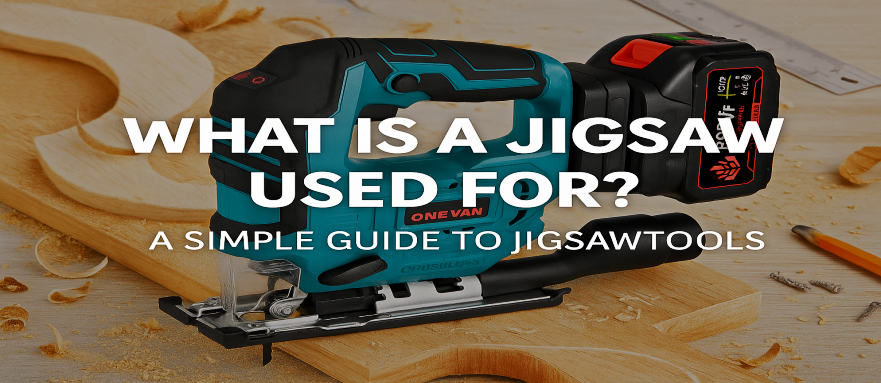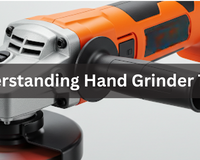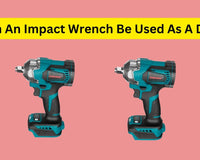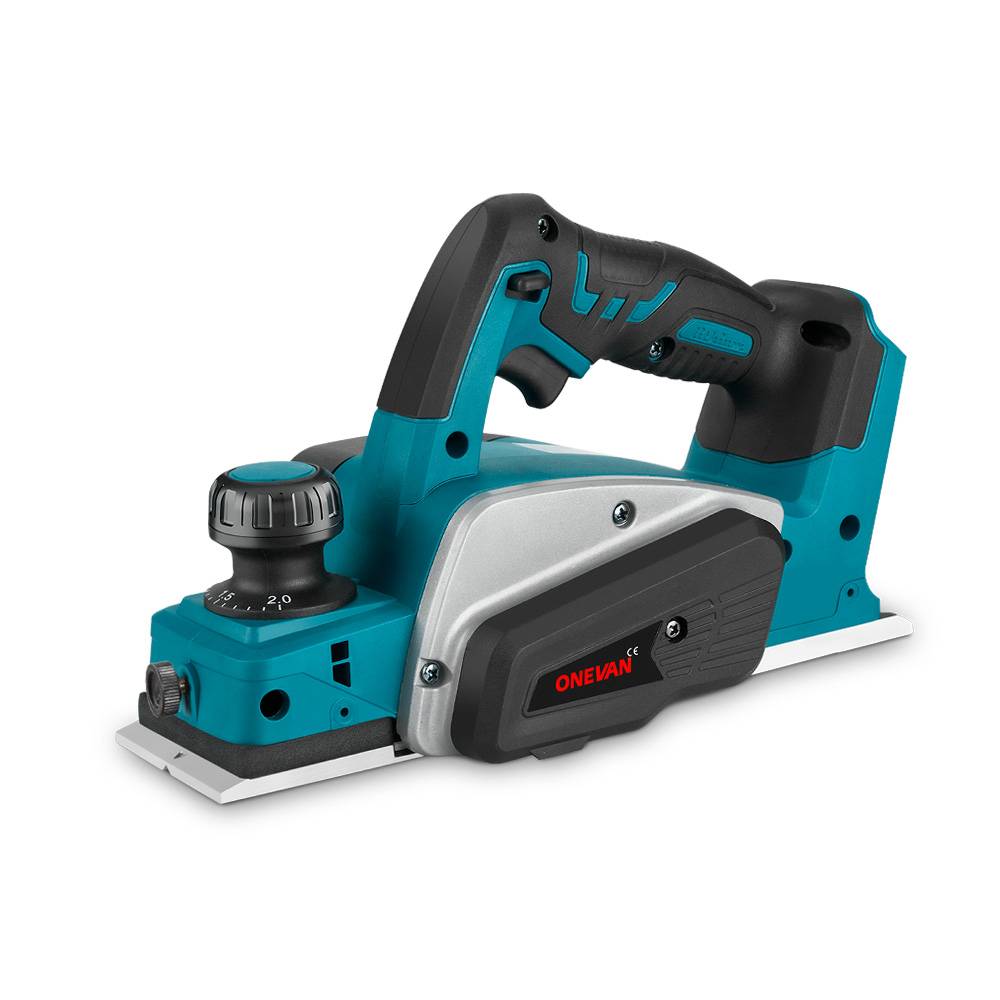A jigsaw is a versatile tool designed for cutting a wide range of materials. It is cool to draw a curved line, a straight cut, or some fun shapes. What is a jigsaw used for? You can use it for home repairs, crafting, or specific construction tasks such as cutting wood for framing. The ONEVAN Brushless Cordless Jigsaw is a great choice because it’s easy and strong. This guide tells you what jigsaws do, which blades to use, and how to cut stuff right. It is ideal for both beginners and those who have previously operated tools. So, let's jump in and see how cool a jigsaw could be!
1. Understanding the Jigsaw Tool
What is a Jigsaw?
A jigsaw is a small tool you hold with your hands. It features a vertically oscillating blade that moves rapidly up and down to effectively cut through a wide range of materials. What is a jigsaw tool used for? It serves to cut wood, metal, plastic, and other materials. You can make straight lines or twisty shapes. The ONEVAN 135mm Brushless Cordless Jigsaw doesn’t need a cord, so you can use it anywhere. It’s lightweight, ergonomically designed for comfortable handling, and equipped with a powerful motor that provides extended runtime.
You can make the blade go slow or fast, depending on what you’re cutting. For example, go fast for wood and slow for metal. The tool features a flat bottom to maintain its stability. You can tilt it to cut slanted lines up to 45 degrees. This makes jigsaws great for a wide range of jobs, such as building a toy box or repairing a shelf.
The History of Jigsaws
Jigsaws originated in the 19th century, initially as manual tools, with the first electric jigsaw introduced by Bosch in 1947. People used their feet to move a saw to cut wood into neat shapes. It was tough! In 1947, a company called Bosch made the first electric jigsaw. That made cutting way easier. Later, jigsaws got batteries, so no cords were needed. Now, tools like the ONEVAN Cordless Jigsaw can use the ONEVAN 18V Lithium-Ion battery and also can compatible with Makita 18V batteries. They also have lights to help you see. Recent advancements in jigsaw technology have led to improvements in ergonomics, battery life, and cutting precision, making them easier and more efficient to use.
2. Common Uses of a Jigsaw
What do you use a jigsaw for? It’s a tool that can do a lot. It excels at cutting intricate shapes and curves that may be challenging for other types of saws. Here’s what you can do with it, with examples from everyday life.
Woodworking Projects
-
Cutting Curvy Shapes: Jigsaws are ideal for creating swirls and intricate shapes in wood. An example is a curvy edge that can be sliced on a kid's toy box.
-
Building Furniture: What is a jigsaw used for in woodwork? It shapes things like chair legs or table corners. Imagine making a small table with round edges—that’s a jigsaw job.
- Cabinets and Trim: Jigsaws cut perfect corners for cabinets or wall trim. They’re super for fitting baseboards around a doorway or cutting molding for your house.
Fixing and Redoing Your House
-
Floors: What can a jigsaw be used for in your home? It cuts laminate, wood, or vinyl floors. For example, you can trim a floorboard to fit near a door.
-
Walls and Ceilings: Jigsaws are used to cut drywall or wood panels for walls. They’re good for making holes for lights or plugs. Consider the process of cutting an opening for a new light switch, which requires precision and careful measurement.
- Fixing Stuff: Got a broken chair? A jigsaw cuts a new piece to fix it. It’s also great for patching a cracked wood floor.
Crafts and Fun Projects
-
Fashioning Models: Model makers, such as hobbyists who create scale models of cars or houses, often employ jigsaws for precision cutting. They take small and precise pieces. For example, you can create components of a toy train.
-
Decorations: What can I use a jigsaw for in crafts? It carves wood into signs, sculptures, or festive material. Consider creating wooden hearts for Valentine's Day.
- Creating Puzzles: Puzzles can be made from jigsaw puzzles or wooden puzzles. If you’re asking what glue to use for jigsaw puzzles, try a clear craft glue like Mod Podge. What is the best glue to use for jigsaw puzzles? Puzzles are well fastened with a good, clear glue.
Cutting Metal and Plastic
-
Metal Sheets: With the right blade, jigsaws cut thin metal, such as aluminum or steel, up to 10 mm thick. For example, you can shape metal for a mailbox.
- Plastic Stuff: What can you use a jigsaw for with plastic? It cuts PVC, acrylic, or plexiglass. You might make a clear box for a shop display.
Stuff You Can Cut
What do you use a jigsaw tool for in terms of stuff? It cuts:
-
Wood: Soft wood like pine, hardwood like oak, plywood, or MDF.
-
Plastic: Acrylic, PVC, or plexiglass.
-
Metal: Thin aluminum or steel.
- Other Stuff: Drywall, tiles, foam, or laminates. Always use the right blade to cut safely.
3. Common Jigsaw Blade Types and Their Uses
Understand Blade Types
Jigsaw blades are designed for specific tasks. They have big teeth, small teeth, or special designs. Selecting the right blade ensures clean and easy cuts.
-
Small-Tooth Blades: Small-tooth blades typically have 24 to 32 teeth per inch and are ideal for achieving smooth cuts in thin materials such as laminate.
- Big-Tooth Blades: These are high teeth (6–8 per inch). They cut quickly but may leave rough edges. Use them for thick or softwood.
- Special Blades:These blades are specifically designed for tasks such as creating intricate curves or cutting through metal and other challenging materials with precision.
What Jigsaw Blade to Use for Laminate
Laminate chips easily. Use a blade with a large number of small teeth (10–20 per inch). A reverse blade is best. It cuts down, so the top stays nice and neat. This is great for cutting kitchen counters or floors.
What Jigsaw Blade to Use for MDF
MDF is thick and can get messy edges. Use a blade with 10–12 teeth per inch for cutting MDF, prioritizing a high-quality steel blade for durability and clean cuts. It makes clean cuts for things like shelves or cabinet sides.
What Jigsaw Blade to Use for Plexiglass
Plexiglass can crack or melt. Use a blade with 24 teeth per inch made of plastic. Cut slowly to keep it cool. This makes smooth cuts for items such as clear signs or boxes.
What Jigsaw Blade to Use for Plywood
Plywood can get splinters on top. Use a blade with 8–12 teeth per inch. A reverse blade keeps the top clean. This is perfect for making plywood tables or walls.
Which Jigsaw Blade to Use for Wood
For wood, pick a steel blade with 6–10 teeth per inch. For soft wood like pine, use a blade with 8–10 teeth per inch for effective cuts. For hardwood like oak, use a blade with 10–14 teeth per inch for a cleaner finish. Match the blade to the wood’s size and type.
4. Special Jigsaw Blades and Their Features
What are Reverse Jigsaw Blades Used For?
Reverse blades cut when the blade goes down. This keeps the top of your stuff smooth. What is a reverse-cut jigsaw blade used for? It’s great for laminate, plywood, or finished wood. For example, cutting a countertop with a reverse blade gives a clean edge. The ONEVAN 135mm Brushless Cordless Jigsaw uses these blades for awesome results.
What is a Scrolling Jigsaw Blade Used For?
Scrolling blades are really thin and bendy. They’re designed for tight curves and intricate patterns. Use them for things like puzzles or pretty signs. For example, you can cut a star shape in wood for decoration. They’re slow but super exact.
What is an Orbital Jigsaw Used For?
An orbital jigsaw allows the blade to move in a circular motion, not just up and down. This cuts faster, especially in softwood or thick stuff. It’s not good for tiny, detailed cuts. Use it for rough jobs, like cutting boards for a fence. You can change the orbital setting to control speed and neatness.
5. Tips for Using a Jigsaw the Right Way
Picking the Right Blade
Select one that matches the material you’re cutting. Pick one that fits what you’re cutting.
Blade for Wood
For soft wood such as cedar, use a blade with six big teeth for quick cuts. For hardwood like maple, use 10–12 small teeth for clean edges. For plywood, try a reverse blade to stop splinters.
Blade for Metal
Use a blade with 14–24 small teeth for metal. These are called bi-metal blades. They stay strong and don’t get too hot. They’re good for cutting aluminum or steel, like for a car part.
Blade for Plastic
Select a blade with 24 small teeth for use with plastics like acrylic or PVC. Cut slowly to avoid melting. This works for making things like a clear plastic shelf.
Put the Blade in the Right
Make sure the blade is tight. The ONEVAN jigsaw has a quick-change system. Push the blade into the jigsaw until it clicks into place. Pull the blade slightly to ensure it is securely locked in position. A loose blade can mess up your cut.
Set the Speed and Orbital Right
Speed is a big deal. Use a speed of 2,500–3,000 strokes per minute for softwoods. For cutting metals or thicker plastics, a lower speed of 1,000–1,500 strokes per minute is advisable to prevent overheating and ensure clean cuts. Orbital settings enable the blade to move in a circular motion, allowing for faster and more precise cuts. Use high orbital for softwood, but turn it off for plastic or fancy cuts.
Draw Your Cutting Line
Mark your cut with a pencil. Use a ruler for straight lines or a stencil for curves. Check your marks twice. This keeps your cuts right and saves time.
Keep Your Work Steady
Clamp your stuff to a table. This stops it from wiggling. A steady piece makes clean, safe cuts. For example, clamp a board before cutting a curve.
Use the Jigsaw’s Cool Features
Many jigsaws feature lights or laser lines to indicate where you should cut. The ONEVAN jigsaw features a laser to help you stay on track. Use these to make straight or curved cuts more precise.
Check Your Work Often
Stop every few inches to look at your cut. Make sure it’s on the line. If it’s off, fix your angle or slow down. This keeps your project looking nice.
Don’t Push Too Hard
Let the jigsaw do the cutting. Pushing too hard makes the blade dull and the cut rough. For example, go slow on hardwood for a smooth edge.
Stay Safe
Safety is super important. Wear appropriate safety gear, including safety glasses, gloves, and a dust mask, to protect against flying debris and inhalation of harmful particles. Keep your hands away from the blade. Always ensure the jigsaw is turned off, unplugged (or the battery removed), before changing blades to prevent accidental activation. Store the jigsaw safely when you’re done.
Take Care of Your Jigsaw
Clean your jigsaw after every use. Wipe off dust and bits of wood or metal. Check the blade for wear and replace it if it’s dull. Keep the tool in a dry place to stop rust. This keeps your jigsaw working great for a long time.
6. More Ways to Use a Jigsaw
Cutting Circles
To cut a circle, draw it with a compass or a round object. Make a small hole to start the blade. Put the blade in and cut slowly along the line. Use a scrolling blade for tight curves. Try it on extra wood first to practice.
Cutting Slanted Lines
Jigsaws can cut angles up to 45 degrees. Tilt the bottom of the jigsaw to the desired angle. Clamp the stuff tightly. Use a blade with small teeth for clean cuts. This is ideal for creating angled corners in furniture.
Starting Cuts in the Middle
For cuts in the middle, like a hole for a sink, use a plunge cut. Tilt the jigsaw so the blade is above the stuff. Slowly lower it to start cutting. This is handy for kitchen or bathroom jobs.
Cutting Thick Stuff
For thick wood or metal, use a blade with big teeth (6 per inch). Set a high orbital setting to increase cutting speed when working with softwood, but reduce or turn off the orbital action when cutting delicate materials. Stop sometimes to let the blade cool. For example, cutting a thick oak board needs a strong blade and slow work.
Cutting Thin or Breakable Stuff
Thin plywood or plastic can break easily. Use a blade with lots of small teeth and cut slowly. Put tape over the cutting line to stop splinters. For example, tape the plexiglass before cutting to keep it smooth and prevent scratches.
Cutting Odd Shapes
For unusual shapes, such as custom signs, use a scrolling blade. Draw the shape first, then cut slowly. This is great for making things like a name sign for a kid’s room.
7. Picking the Right Jigsaw
What do you use a jigsaw for? It depends on the tool you pick. For new users, get a cordless jigsaw with easy speed buttons. The ONEVAN 135mm Brushless Cordless Jigsaw is awesome for beginners. It’s light and simple. For professionals, choose one with numerous power settings and adjustable orbits. Ensure it works with the batteries you have, such as Makita 18V. Check if it’s comfy to hold for long jobs.
Things to Avoid
-
Wrong Blade: A wood blade is not suitable for cutting metal. Pick the right one every time.
- Bad Speed: Fast speed on plastic can cause it to melt. Go slow for delicate stuff.
-
Wiggly Stuff: If it’s not clamped, it’ll move and mess up your cut. Always clamp it.
- No Safety Stuff: Dust can hurt your eyes. Wear glasses and stay safe.
8. Conclusion
What is a jigsaw best used for? A jigsaw is a versatile tool suitable for a variety of projects, including construction, home repairs, and crafting. It cuts curves, lines, and shapes in wood, metal, plastic, and more. With the right blade and some practice, you can make stuff look pro. The ONEVAN 135mm Brushless Cordless Jigsaw makes it super easy to get great cuts. From tables to decorations, a jigsaw can do it all. Grab one and start creating something cool today!
9. FAQs
What is the best jigsaw for beginners?
New users need an easy jigsaw. The ONEVAN 135mm Brushless Cordless Jigsaw is perfect. It’s cordless, light, and has simple speed controls. It’s great for starting.
How do I choose the right jigsaw for my needs?
Think about what you’ll cut. For wood, get one with speed and orbital options. For metal or plastic, ensure it is compatible with special blades. Pick one that feels good in your hands. Lithium-Ion battery life is important for cordless ones.
Tags:
jigsaw uses, what is a jigsaw used for, jigsaw tool, jigsaw blades, woodworking tools, ONEVAN jigsaw, cordless jigsaw, reverse jigsaw blades, scrolling jigsaw blades, DIY projects









